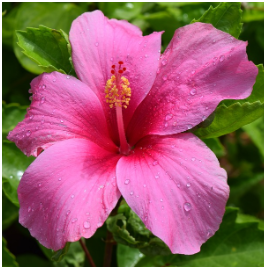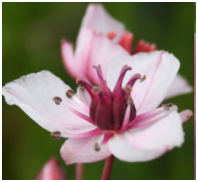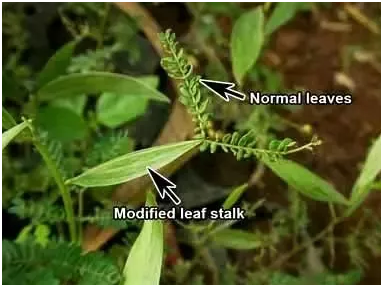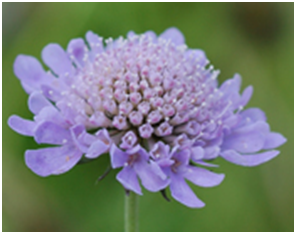The position of the ovary in the flower shown is:

1. Superior
2. Half superior
3. Inferior
4. Half inferior

2. Half superior
3. Inferior
4. Half inferior
Identify the corolla aestivation shown in the given picture of a flower:

1. Valvate
2. Twisted
3. Imbricate
4. Vexillary
Match each item in COLUMN I with one in COLUMN II and select the correct answer from the codes given:
|
|
COLUMN I [Fruit name] |
|
COLUMN II [Edible part] |
|
A. |
Apple |
a. |
Juicy placental hair |
|
B. |
Guava |
b. |
Thalamus and pericarp |
|
C. |
Orange |
c. |
Fleshy thalamus |
|
D. |
Litchi |
d. |
Aril |
Codes
A B C D
1. b c d a
2. b d a c
3. c b a d
4. d c b a
Look closely at the gynoecium of the flower in the picture. The description of this gynoecium will be:

1. apocarpous monocarpellary
2. apocarpous multicarpellary
3. syncarpous monocarpellary
4. syncarpous multicarpellary
In Acacia, the modified leaf stalk shown are called as:

1. Phylloclade
2. Cladode
3. Phyllode
4. Hydathode
Leaf tendril shown in the picture can belong to:

1. Gloriosa
2. Opuntia
3. Ficus
4. Acacia
Match each item in COLUMN I with one in COLUMN II and select the correct answer from the codes given:
| COLUMN I [Modified tap root] |
COLUMN II [Example] |
||
| A. | Fusiform | a. | Radish |
| B. | Napiform | b. | Turnip |
| C. | Conical | c. | Carrot |
| D. | Tuberous | d. | 4’ O Clock plant |
Codes
| A | B | C | D | |
| 1. | a | b | c | d |
| 2. | b | a | d | c |
| 3. | c | d | a | b |
| 4. | d | c | b | a |
The type of inflorescence seen in the flower shown is called as:

1. Spadix
2. Corymb
3. Umbel
4. Capitulum
Match each item in COLUMN I with one in COLUMN II and select the correct answer from the codes given:
| COLUMN I [Modified adventitious root] |
COLUMN II [Example] |
||
| A. | Prop or stilt | a. | Betel |
| B. | Haustoria | b. | Orchids |
| C. | Epiphytic | c. | Dodder |
| D. | Climbing | d. | Banyan |
Codes
| A | B | C | D | |
| 1. | a | b | c | d |
| 2. | b | a | d | c |
| 3. | c | d | a | b |
| 4. | d | c | b | a |
The Great Banyan Tree is over 250 years old and covers about 14,500 square meters of land (3.5 acres) in the Acharya Jagadish Chandra Bose Botanical Garden near Kolkata (Calcutta), making it the widest tree in the world. From a distance, the tree has the appearance of a forest, but what appear to be individual trees are actually aerial roots- around 3,000 of them. These aerial roots are called:
| 1. Haustoria 2. Pneumatophores 3. Prop roots 4. Climbing roots |
 |






